#bunad basics
Explore tagged Tumblr posts
Text
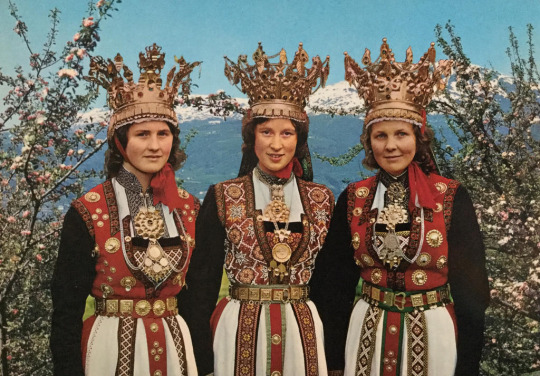
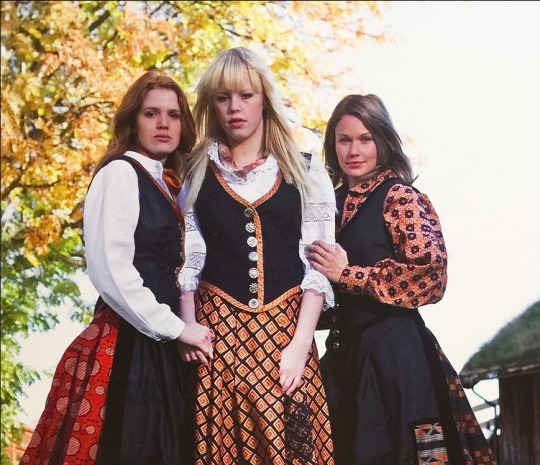
Bunad Basics: the Terminology
What does "bunad" mean? How is it different from a "festdrakt" and what on earth is a "fantasistakk"?
On this blog I use a number of terms that may be confusing if you're not already immersed in the world of historical fashion and traditional Norwegian folk costumes. Since my goal here is to make this world more accessible to anyone who may be interested, I figured I should make a glossary of sorts.
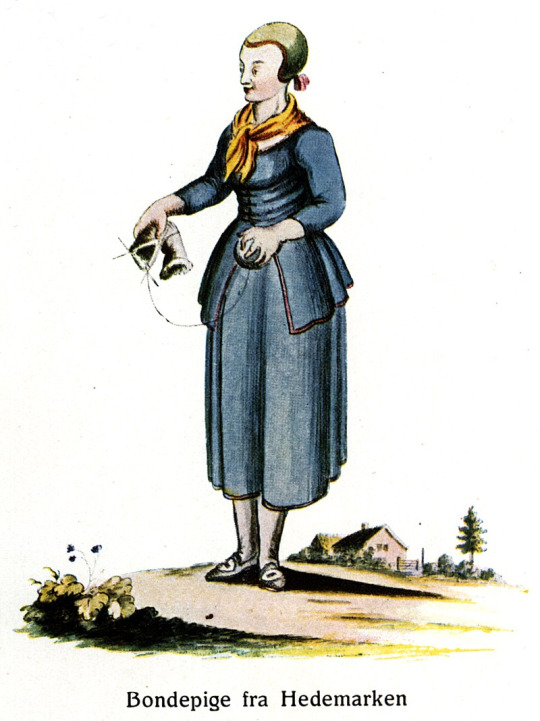

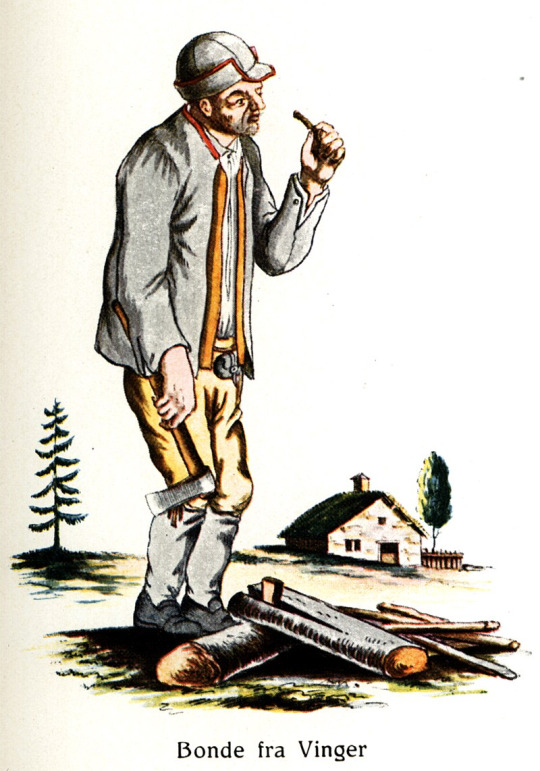
Illustrations by Johan F. L. Dreiers
Folk Costume
This is an umbrella term that refers to any complete costume has been constructed using traditional techniques.
While the word "costume" today has connotations to playing a character in, say, a show -in this context it simply means an outfit.
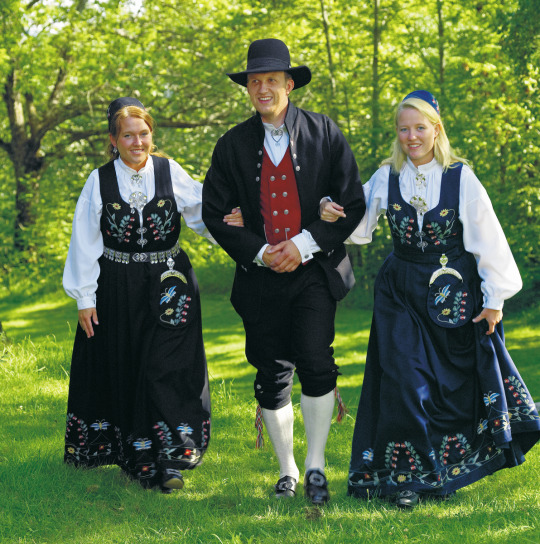
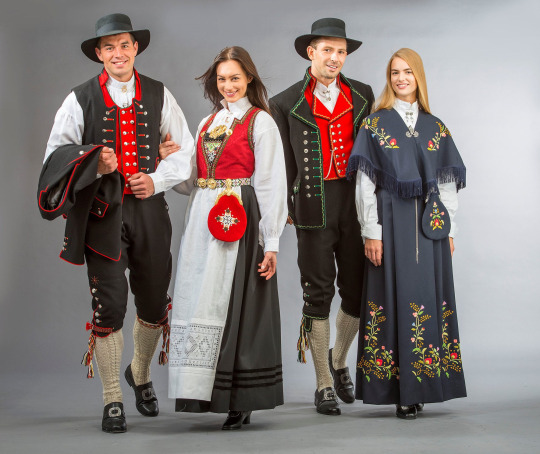
Bunad [bu:`nad]
From old norse: búnaðr. May be directly translated as "to be used at home".
In modern Norwegian the word refers to a type of formal folk costume that represents the traditions of a specific geographical area. The platonic ideal of the bunad is that it should show exactly where you are from, where you consider your "home". Not every adult norwegian has a bunad, but it's common to recieve one from a family member as your 15th birthday gift. You're expected to only own one bunad for the rest of your life (unless you pass it on to the next generation).
There are around 450 distinct bunads in Norway, according to Store Norske Leksikon. While there tends to be a common consensus of what regional traditional costumes are considered real bunads and not, there is no official registry of bunads. The number of 450 is an estimation, and there tends to be disagreements on who is allowed to call their folk costume a bunad.
Some bunads have deep roots and has been in continoous use for hundreds of years, while others are only loosely based on a few archeological finds. The definition is often up for debate.

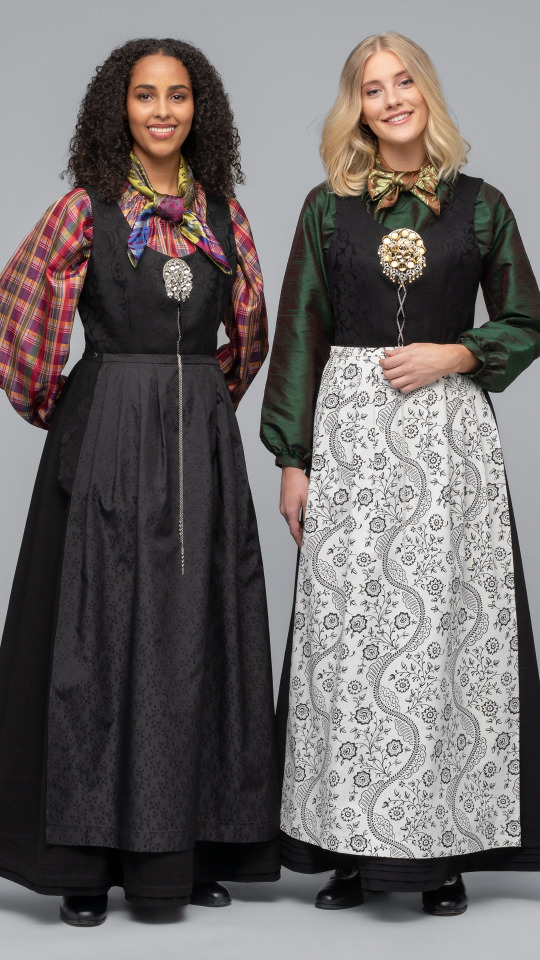
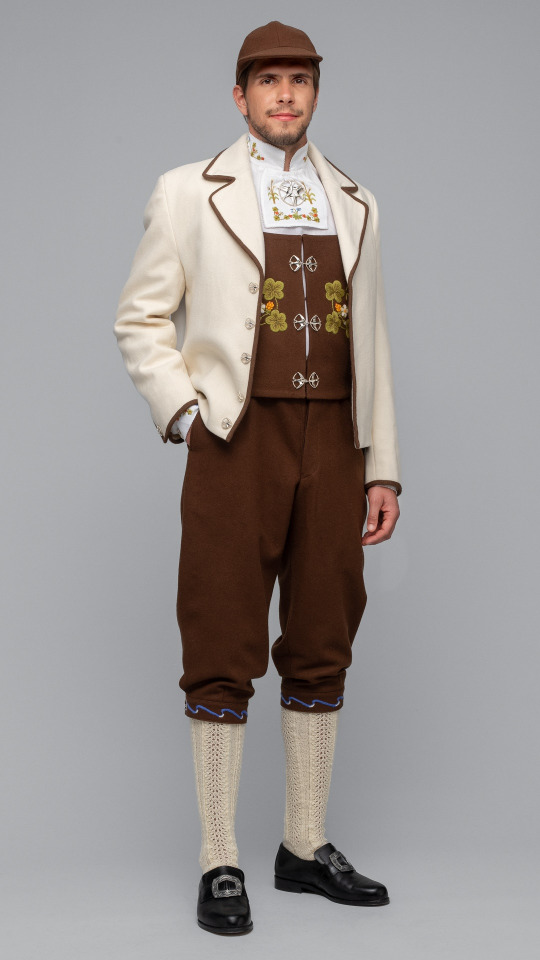
Left to right: Festdrakt originating from Tromsø, Northern Norway, and Senja
Festdrakt
May be directly translated as "celebration-costume".
A festdrakt is a formal traditional outfit that is not considered the absolute represenation of a specific geographical area. It may be inspired by local traditions, but has for some reason not been granted recognition as a real bunad.
If you can trace the composition of a folk costume back to a specific designer, it will most likely be called a festdrakt. Though a few costumes that fill this requirement are commonly considered bunads regardless.
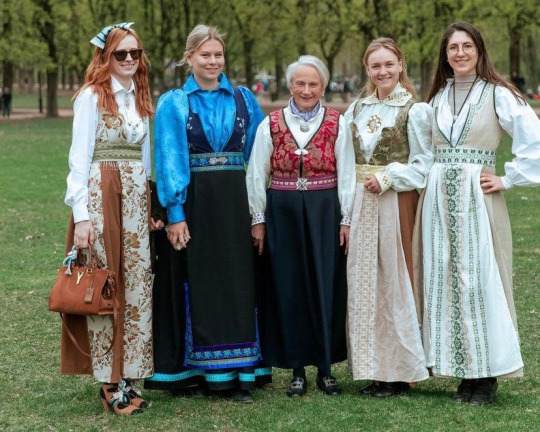
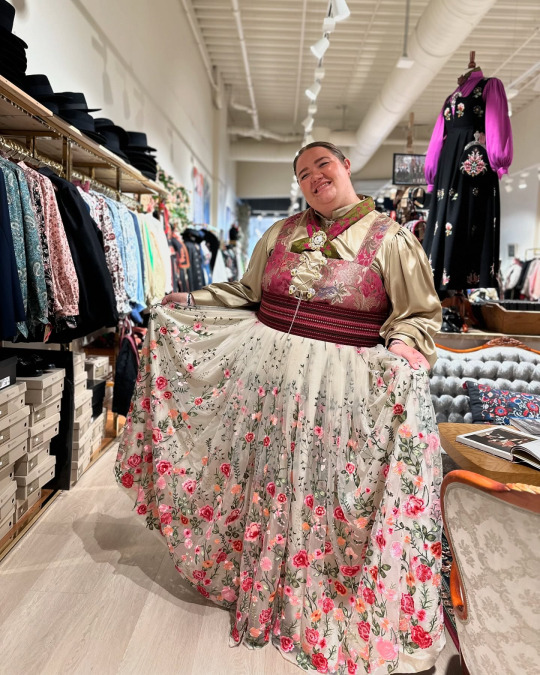
Left: women wearing homemade fantasistakk. Right: woman wearing the fantasistakk "alvedrakt" by fashion house Embla Bunader
Fantasistakk
May be directly translated as "Imagination-dress" or "fantasy-dress".
This is a relatively new term that was born from a modern folk fashion movement. In recent years it has become popular to design a "bunad" from your own imagination, and sew it yourself from any materials you have available.
The motivations behind doing this vary, but a few common reasons are: - wanting to wear something beautiful on important occasions, but not having the money to buy a "real" bunad - feeling overwhelmed about choosing a bunad, so instead going for an option that represents your own personality instead of a specific place of origin - wanting to learn how to sew traditional garments, but being intimidated by the near sacred status of the bunad. - just thinking they look cool
Some fashion houses, like Embla Bunader and Eva Lie have become known for coming up with avant-garde fantasistakk designs.
Bunadspolitiet
Another young term. "The bunad police". This is not an actual authoritarian force, but rather a name for people who feel it's their moral obligation to call out anyone who uses bunad "wrong". Often used as a kind of "boogey man" in discussions about bunad.
These are just a few terms that tend to pop up, if you have any other words you'd like me to explain, ask away!
7 notes
·
View notes
Text
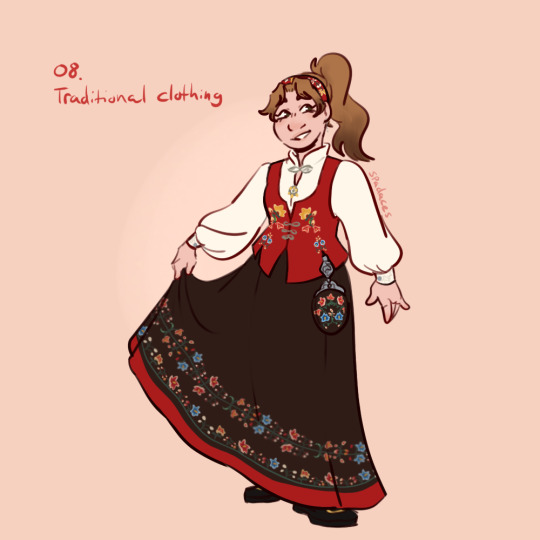
Oc-tober day 8: Traditional clothing
Decided to be very self indulgent with this one and do Norway's traditional garment - the bunad! While fictional, the city Aurora Eline is from is basically a combination of scandinavia, so she's often the character I project the most "norwegianess" onto haha - I even gave her the same bunad I personally own :]
Prompt list under the cut!

Prompt list by Askanslostfins on tik tok
#I really truly love bunader they're so prettyy and I should practice drawing them more#there's so many different types (based on various areas in norway) and all are so intricate and unique#oc tober#oc-tober#oc tober 2023#october challenge#dnd#oc tag#art tag#oc: Aurora Eline#mirrors and memoirs
8 notes
·
View notes
Text
Holy crap, and these are the people complaining their craft is dying out. How did they think embroidery was traditionally taught?
Because I was 4 and my stitch count was counted in inches per stitch. My first "real" embroidery had a whopping 3 spi. After which I ditched my familial teachers unless things had gone tits up, and just worked my way up to a "40 hours per repeat, 5-8 repeats recommended (:" pattern.
And when I shashayed my butt into Norway, my school friends were happy to teach me white on white embroidery for a bunad shirt (still regret politely declining for fear of making a cultural faux pas).
Was their traditional embroidery perfect? Fuck no, we were 19 and discussing how open we were to menacing fir trees during Russ as she was doing it. But artisan level work was several thousand kroner, which is a lot on a teenager budget for the collar and cuffs of a shirt you will still grow out of, if not outright stain and wear out in the coming decade of weddings you'll attend, and which no one is gonna see in that much detail unless they're your mom, or they're the kind of person who you'd want to involve in the aforementioned tree-menacing. (And if they are gonna critique your embroidery at that point, you push them out of the damn tree.)
There's several thousand hours between learning a technique and being an expert at it. You do not need to be at expert level to teach someone enough basics that a library book on the subject starts making enough sense to be useful. You do not need to be at expert level to give someone enough skill to feel confident to muddle on unsupervised and see where it takes them.
"You want to reinterpret this in a way that would not have been acceptable for royalty 200 years ago, so I'm going to insult your ability" is a dick move, and it's been the death knell of several crafts over the last decades.
Last year I met with a local embroidery expert to ask her opinion on making a line of stick-and-stitch patterns that would make it easier to adapt folk embroidery patterns to modern garments like hoodies and t-shirts, and maybe even teach rare folk embroidery stitches that have fallen out of popularity with the proliferation of cross-stitch.
She... looked at my 8 stitch per inch product samples, and samples stitched by beginners and my niblings, and advised me to stick to embroidery patterns I was actually competent at before purporting to teach anyone else. Before trying to market anything as connected to a specific folk tradition, I should, how should she say... learn to be actually good at embroidery.
(I can mostly take criticism on the chin, but I did cry a bit when she talked about limiting myself to "techniques you're physically capable of" because if I go too hard on handsewing the nerves in my arms go on strike for a couple weeks, so that would limit me indeed, but like, she did mean well. In a strict high-standards way.)
Soooo when I got home I picked up a test copy of my Jane Seymour pattern I'd put aside because it printed out at a masochistically small gauge, and started stitching it out of pure spite. I've been working on it in slow inches for half a year now.
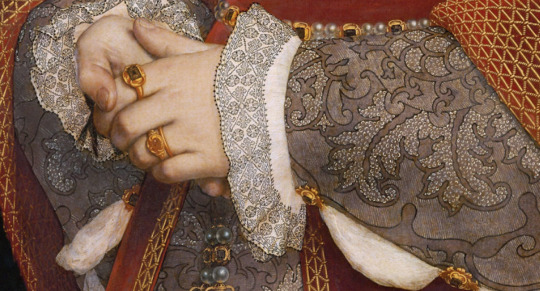

Anyway, that's a pattern that will finally go up on the shop this month! At a slightly bigger and more reasonable size, and printed more cleanly.
96 notes
·
View notes
Text
im gonna be in norway for my birthday, eurovision, and the 17th of may... wrow
#woof#17th is basically their independence day they have parades n stuff#felix is considering getting me a bunad to wear hhehehe#(not an authentic one bc theyre super expensive but still)
3 notes
·
View notes
Note
Thank you for your answer, sorry if it was weird. And yeah, my friend is basically asking if it’s okay if she can love her Norwegian culture😂 I don’t know why she’s scared of liking her culture (it would be weird if she loved Norway’s history however😟 she don’t btw), she just don’t want to offend people. I mean, it’s nothing wrong with it as long as she’s aware of her country’s history, listen and learn from the groups that suffered because of Norway and support and help raising awareness without speaking over the voices to those who were and are affected?
Sorry for venting, I suppose she’s just having her moment of Norwegian guilt or whatever??
I’m not trying to sound mean but I think the real issue here isn’t that she loves her culture, it’s that she feels the need to go ask random marginalized people to validate her and tell her that it’s okay to be norwegian. I’m far more bothered by being asked if I hate norwegian people just because I talked about colonialism than I am by a norwegian person learning traditional dancing or wearing a bunad or whatever. I didn’t say I dislike norwegian people and I think you guys are reading anger into my words for no reason and that’s very frustrating. I shouldn’t have to comfort people who feel guilty about their privilege every time I want to talk about issues that affect me.
but yes, it’s okay to like her culture, good for her and I think the bunad is iconic
43 notes
·
View notes
Text
The Bunad: roots of a nationalist symbol
The bunad is a Norwegian folk costume which exists in many regional varieties. A symbol of rootedness and belonging both local and national, the bunad is ubiquituous on Constitution Day, 17 May, but it is also used at other festive occasions. Although it is far more widespread among women than men, male bunads have become common in some social circles.
Can anyone wear a bunad? Is it a real bunad if it is made in China? Is it a symbol of origin and roots or a nationalistic symbol?

It is estimated that Norwegians own altogether 2.5 million bunads, worth more than 40 billion kroner (€500 million). In other words, one in two citizens owns a bunad, and they are expensive garments with embroideries and filigree silver ornaments, consisting of several components often including aprons, headdresses, scarves or shawls. You could easily buy a few prestigious and beautiful dresses from famous designers for the cost of a single bunad. Moreover, bunad ownership and use has grown fast in the last few decades.
The increased popularity of bunads could be put down to the growing prosperity of the population of oil-rich Norway in general. But this is hardly the whole story. A symbol of Norwegianness, rootedness and regional origins, wearing a bunad is a statement about identity. Non-Norwegians are often puzzled by its widespread use, since folk dresses are associated with minorities in other parts of Europe. Perhaps the Norwegian identity is essentially a minority identity, even though independence was achieved through a bloodless secession from the Swedish–Norwegian union in 1905.

The ongoing story of the bunad is complex and involves claims and counter-claims about authenticity, the feared and respected ‘bunad police��� and a vivid popular discourse about who has the moral right to wear which bunad. The right not to wear a bunad is generally tolerated, but there is no strong and visible cosmopolitan discourse dismissing the widespread love of folk costumes as antediluvian, reactionary, nationalist and possibly racist. Yet there is no consensus concerning which dresses should be classified as sufficiently authentic and what the criteria are and it has led to controversies.
The bunad is a particular kind of festive dress. The term is a neologism based on an archaic dialect word, introduced in urban circles by the author and nationalist activist Hulda Garborg in her pamphlet Norsk klædebunad in 1903. Writing during a feverish phase of Norwegian nationalism just ahead of independence, Garborg argued the need for a truly Norwegian and regional form of formal dress. She collected and systematised what she saw as intact and useful regional bunad traditions, and even designed some bunads herself. Interestingly, Garborg never denied the syncretic and partly invented character of the new, traditionalist folk costume. She nevertheless emphasised its role as a marker of rural, Norwegian identity.
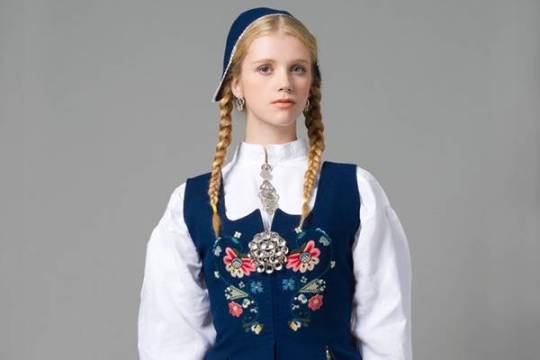
A relevant distinction can be drawn between a bunad and a folk costume. Folk costumes are everyday and festive clothes which were traditionally worn by peasants in southern Norway, and – like certain kinds of peasant food – have been recontextualised and upgraded more recently as formal dress. Bunads, on the contrary, are reconstructed and re-designed – sometimes very nearly purely invented – costumes designed from the early 20th century onwards, and are used at occasions such as Christmas Eve, Constitution Day, weddings and other major social events, although not at funerals: bunads are bright and joyful garments. Some bunads represent minor adjustments (‘upgradings’ and modernisations) of the original folk costume, while the link is less obvious or absent in other cases.
The bunad is an important traditionalist symbol of modern Norwegianness. Most of these costumes are related to regional and minority folk costumes from Central and Eastern Europe, and the German influence has often been commented upon. More importantly, the bunad confirms Norwegian identity as an essentially rural one, where personal integrity is linked to roots and regional origins. However, 18th and 19th century peasants would often wear European-style dress at formal occasions such as weddings, or they might wear a folk costume, which gradually went out of use. In other words, there is a clear element of modern invention, which nobody denies, not only in the currently widespread use of bunads, but also in their design.

What exactly, then, is a bunad? One possible answer widely accepted is: a festive dress associated with a regional Norwegian tradition, accepted by the Bunad and Folk Costume Council as such, and widely recognised as a bunad by the public. Its popularity as a symbol of tradition has increased proportionally with the modernisation and urbanisation of Norway in the last hundred years, thereby saying something essential about the politics and poetics of identity in modern societies, where the quest for rootedness in the past increases with de facto uprootedness.
In contemporary society, many if not most individuals have two, three or four options: they can legitimately wear a bunad designed in the place where they live, in the place where they grew up, or in one of their parents’ places of origin. They cannot, however, legitimately wear a bunad from wherever they fancy. Of course, they could buy it, but their friends and relatives might frown.
Norwegians who live in the heart of urban cities and have no real rural roots are sometimes unaware of people in the heart of Bunad Norway who are deeply offended. These rural Norwegians as they see it have no time for West End ladies who claim Telemark ancestry when they buy the perhaps greatest status symbol of all bunads, namely the expensive and exclusive East Telemark bunad. They also disapprove of people wearing gold chains and earrings with their bunads.

There are frequent conflicts over authenticity framed within the bunad discourse itself. In the valley of Numedal, competition between two alternative bunads actually led to the creation of two distinct factions in the 17 May parade of 2002. Family members fell out with each other; local politicians groped for compromises. One of the alternatives, a simple folk costume, is woven in dark fabrics; the complex, reconstructed bunad sanctioned by the Bunad and Folk Costume Council is much more elaborate and colourful. The defenders of the simple costume argue that the new one, ‘overloaded with silver and embroideries’, is inappropriate and clearly inauthentic for a traditionally poor mountain valley; while the other faction see the simple bunad as sordid and joyless. Both factions claimed that their bunad was the most ancient one. The colourful and expensive alternative won in the end.
The bunad stirs up strong emotions. After the 17 May celebrations in 2001, Queen Sonja was criticised in public for wearing sunglasses with her bunad; in the same year, Crown Princess Mette-Marit was severely reprimanded in the press for wearing a purely invented ‘fantasy costume’ rather than an authentic bunad from her home region. She has since made amends, and now has several bunads to choose between (legitimate in her case, being princess of the whole realm), including an elaborate bunad from her home county of Vest-Agder in the far south of the country. Women are generally advised by the Bunad and Folk Costume Council not to wear makeup and earrings with their bunad.

Because of the wealth of detail, a proper bunad cannot be made industrially in its entirety. This partly accounts for its high market price. Moreover, the knowledge and skill required to make a bunad is considered a cultural, local form of knowledge – a kind of inalienable possession. In the spring of 2002, a conflict erupted between the traditionalists and a young entrepreneur who wanted a slice of the market. This conflict inadvertently brought the implicit ideology underlying the bunad to the public eye. The controversy is still alive today, with cultural arguments overlapping with the economic ones.
What happened was this. A young Norwegian of Chinese origin, who originally worked as a cook, began to take an interest in bunads. He took a bunad course, learning the basics of the craft. Before going into business, he changed his name from Aching to John Helge Dahl, realising that he would have little credibility as a bunad salesman with a Chinese name. (The current owner of the company founded by Dahl is nevertheless called You Hong Bei.)
Dahl founded a company called ‘Norske Bunader’ (Norwegian bunads), and then he did the outrageous thing, namely to contract dozens of Chinese seamstresses in Shanghai to do the stitching and embroidery. The fabrics were sent from Norway, and the completed garments were returned – at a much lower price than that of the Norwegian competition. He built the bunads himself. ‘To most people, it is the quality that counts,’ he says, ‘not who has done the embroidery’. Of course, he can offer bunads at a competitive price.
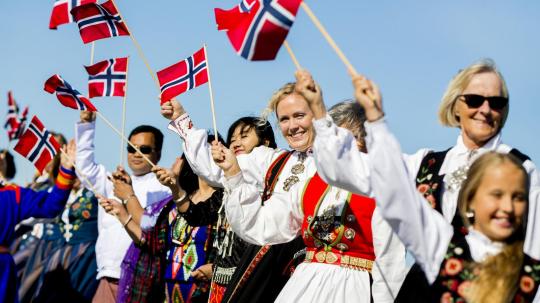
The Bunad and Folk Costume Council reacted strongly against Mr. Dahl, as did Husfliden. At one point the latter threatened to sue him for plagiarism, but since bunad designs are not copyrighted, they were likely to lose a court case. Their argument was that the craft amounted to a locally embedded kind of knowledge which did not travel well, comparing it to dialects. Talking about mass production and industrialisation of bunad production, they argued that the use of foreign labour leads to cultural flattening. The resulting products were said to have no hau, to use the anthropologist Marcel Mauss’s term for the ‘soul’ of an object.
Opinions bitterly divided people. Many who defended the traditionalists said that this concerns ‘personal knowledge’. Bunad embroidery was a kind of handwriting. They argued that when anyone can take a pattern, send it abroad, and make a good profit from the product, people will ask: ‘What is it that I am spending one or two months��� salary on?’ Many argued that this kind of garment would feel alienating, and that it would not satisfy people’s emotional need to build their own history into the garment.
Another argument concerns the low salaries in China, claiming that it was immoral to hire ‘underpaid women’ to do this kind of work. Dahl’s Shanghai seamstresses were paid what he described as a good salary in China, but which is a fraction of a comparable Norwegian salary. Yet others have said that it may be acceptable to employ immigrant women living in Norway, who may have assimilated some local skills, but not to employ foreign women living abroad.
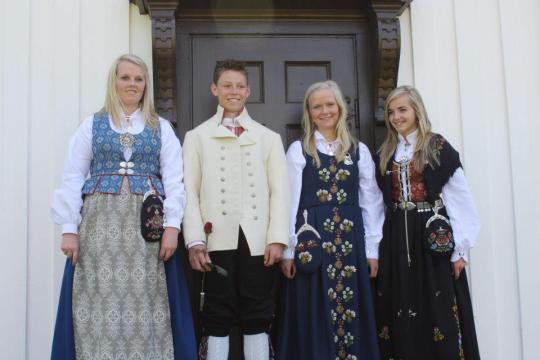
Although the Dahl case was spectacular in that it simultaneously brought out both accusations of racism and controversy concerning criteria for authenticity, his business innovation was less original than it might seem. Several producers admit that they outsource parts of their production to the Baltic countries and elsewhere where wages are low, and even Husfliden has admitted that parts of their bunads are made industrially because of the high cost of labour in Norway.
The anxieties voiced by the critics of the outsourcing of bunad production are threefold: In a thoroughly neo-liberal society (anyone can wear what she wants; anyone can design and make bunads anywhere in the world), national identity suffers because regional roots are severed; economic interests suffer because prices go down; and the personal or emotional pole of the user suffers since the garments lose their special quality.
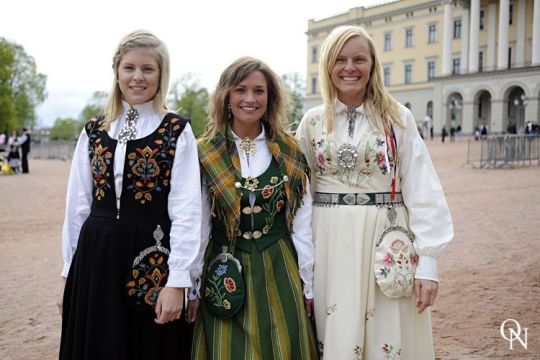
In what exactly does this ‘special quality’ consist? What is the nature of the considerable personal capital invested into clothes?
What is reaped from this investment is a handsome profit, an enhanced sense of community and visible boundaries to the outside world. Cultural property of this kind is intangible, it is legally oblique, and it is poised to lose against both the brisk efficiency of contemporary capitalism and against the individualism of free choice.
So the main question as I see it: is what price your heritage?
Put your secret/sacred knowledge online, and the spell is immediately broken.
This kind of knowledge has to be scarce, localised and difficult to obtain, or it loses its magic qualities. Beyond pricing policies and profits, this is what stirs the souls of the people who care about the national and regional provenance of their bunad. Had they chosen a Dior dress instead, or a pair of blue jeans and a nice T-shirt, the problem would not have arisen.
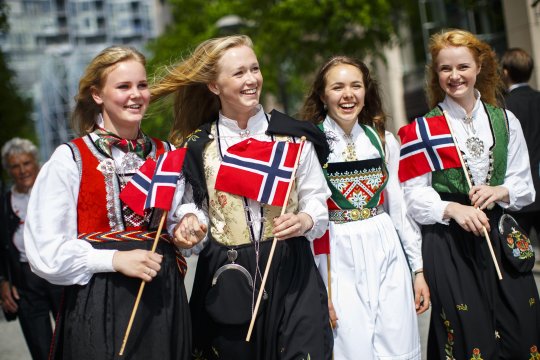
Still critics argue why all the fuss? The Bunad is no different from what a kilt is to a Scotsman or a lederhosen is to the Bavarian or a sari is to an Indian. Yes and no. Each of these have differing degrees of exclusivity and symbology.
The kilt arguably was an English invention to control the Highland clans. But it became something else - a national symbol of being loyal to clan, crown and country. It used to be people only wore kilts if they had a hereditary claim to that tartan but nowadays no one really cares what tartan you wear (much to the chagrin of older generations). The lederhosen has always been a regional symbol not a national one but has been ‘McDonalised’ to an Oktoberfest fancy dress costume party. The sari is an interesting example that remains a distinctly Indian national symbol but can also now be readily worn by anyone around the world - just as well as I love wearing saris at Indian weddings and when I lived in India. But the Bunad is different because of its own distinct roots that has never left its national borders. The Bunad is a living tapestry and its threads can’t be simply out sourced to other countries.
One’s heritage should never be outsourced. To the anti-traditionalist naysayers I would say that the bunad is a special kind of garment saturated with symbolism and existential significance; it is from somewhere, not from anywhere. It’s Norwegian, born and bred.
228 notes
·
View notes
Text
Pairing: Sonny Carisi x Norwegian!Reader Fandom: Law and Order SVU Requested: No A/N: I’m Norwegian (for those who didn’t know, and I had this idea all morning, and wanted to write it before I forgot it! Hope y’all like! -Karen
MASTERLIST!
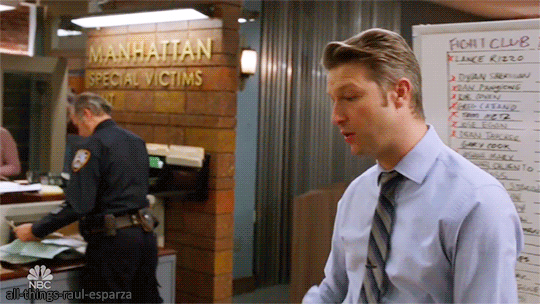
«Hey lieu! I need to ask you a favor», you said, looking over at Liv. «Okay? What’s up?» she asked returning the gaze. «So my family is in town for the weekend and I was hoping I could get Sunday off.» You knew it was worth a shot trying to get the day off. Being one of the newest members to the team and seeing as it was starting to pick up on crimes in the city, you’d be surprised if you got a yes.
You could see she was thinking about it, her face scrunching up a bit. «I can switch with you if you want (Y/L/N)», Sonny offered, looking at you. «You sure Carisi?» you asked, he had been looking forward to his day off for a while, as he had told everyone. «Yeah I’ll just go see my family later, it’s fine (Y/L/N), you don’t get to see your family that often, I see mine all the time», he reasoned. Giving him a wide smile I thanked him before looking at Liv again.
«Okay, yeah, I’ll note the switch!» she said, going into her office and closing the door behind her.
«Thank you again Sonny!» you said, hugging him. «No problem (Y/N)», he replied, gifting you with a soft smile.
…
You had been over the moon happy when your parents had offered to fly over to New York for the constitutional day parade in Brooklyn. It was the first time you weren’t celebrating the big day at home, so it would be new, but your mom had brought over your bunad to make it as similar to home as possible.
…
The parade was over and you had all gathered in a restaurant to eat dinner when your phone rang. «Detective (Y/L/N). Oh. Uh, yeah, I’m on my way.» You sighed, it had been too good to be true that you would get the day off. «I’ve been called back in to work mom, can you stop by my flat and get the bunad bags and a change of clothes?»You asked your mom, looking at her. «Yeah of course! I’ll text you when we leave your flat», she replied.
«Let me drive you!» your brother offered, getting up. «That would be nice», you said, going round to give everyone a hug and telling them to have a good celebration in your absence.
…
«I’m here!» you called, a little out of breath. «Detective?!» Sonny gasped, looking at you. Giving him a small smile you turned to your brother and thanked him for the ride. «I’ll see you when mom comes back with my stuff», you said, sending him on his way.
«So where were we?!» you asked, trying to get people’s attention away from you. «Where were you?» Amanda asked, looking at your clothing. «We were celebrating the Norwegian constitutional day in Brooklyn—can we focus on the case please?!» you groaned.
Looking down on your phone you let out another groan. Your brother was stuck in traffic on his way back with your mom and the things you asked for. It would be some time before they showed up, meaning you would have to work in your bunad until they arrived.
…
«Hey (Y/L/N) I just want to say I think you look really nice», Sonny said, looking over at you from his desk. «Thank you Carisi», you said with a blush.
You would be lying if you said you didn’t harbor some feelings for your partner. How cliche huh? Falling for your partner. Must be the oldest joke in the books of workplace related shenanigans. Yet here you were blushing like an idiot just because Sonny Carisi complimented your outfit. He was probably just trying to be nice, and here you were taking it way to easily to heart. Get it together (Y/N), you inner demons said.
…
You’d been going through most of the files by the time your mom and brother were escorted over by an officer. «Detective (Y/L/N)? Someone here to see you!» the officer said, catching your attention. «Thank you!» you called back, hugging your mom and brother.
«Lieu! I’m just going to change!» you said to Liv. Getting a thumbs up you went to the changing room with the bags your mother brought with her, leaving her and your brother to wait in the bullpen. As much as you loved wearing your bunad, it was heavy, and warm, and the shoes felt like they would never get worn in to the point where they were comfortable.
Upon reentering the bullpen you could hear laughter and saw everyone crowded around your mother holding her phone. «Mom!» you groaned, «Don’t embarrass me in front of my colleagues!» you added, glaring at her.
«You were such a cute baby!» Sonny commented, smiling at you. Glaring at him too, you swooped in and snatched your mom’s phone from her hands. «If there’s more comments I will end all of you!» you stated, giving them a I’m not kidding stare.
«It was nice to finally meet you all. My daughter speaks highly of you all, especially you Sonny», you mother said, looking at your team before her eyes settled on Sonny’s blushing face. «Mom! Please stop talking!» you groaned, hugging her and your brother one more time before basically pushing them into the elevator, «I’ll see you at home!»
…
It was a quarter to 9 in the evening when you finally got to leave. «Sorry you didn’t get to spend time with your family», you said, looking at Sonny. «Right back at you.» you snorted at his comment. «Can I drop you off at your apartment?» he asked, his eyes fixed on yours. «That would be nice, thank you Sonny», you murmured, letting him lead you to his car.
The ride over was mostly quiet, the radio filling the void. «Your mom and (y/b/n) seemed nice», Sonny commented, looking over you briefly before fixing his eyes on the road. «Yeah, they’re amazing, a little nosy at times, but mostly great», you stated, smiling softly at him. «And I wasn't lying back there, you really did look amazing in that outfit you were wearing», he said with a chuckle, making you blush, trying your best to hide it from him.
«Well, here we are», he commented. «Thank you for the ride Sonny», you said, looking at him before looking at your hands. «I’ll see you tomorrow.» «Yeah, I’ll see you tomorrow», he said, sounding almost sad that the night was over so soon.
Getting out of the car you made your way to the door when the sound of a car door slamming shut and Sonny calling out for you to hold up broke the air. You almost knocked yourself out by the sheer force of turning around. «Yeah?» you asked, looking at him, «You forgot your phone», he murmured, holding out the device. «Oh», was all you could say, taking your phone from his hand, your fingers slightly gracing.
You almost didn’t dare look at him after the bolts had settled in your blood. «Thank y—», you muttered as his lips pressed against yours in a soft kiss. The intimacy ended quickly however as Sonny pulled away, looking at you with a shocked face at what he had just done. «I’m sorry, I didn’t think, I sho—.» a moan slipped his mouth as you pulled him back in for another kiss.
Neither of you seemed to want to pull away, but when you did, you were standing there in each others arms, panting for air. «I’ve wanted to do that for a while», he murmured, caressing your cheek with his thumb. «Yeah, me too», you mumble, your fingers playing with the ends of Sonny’s hair. «I want to do that again», his voice was almost a whisper at this point. «I’m not stopping you.» He almost dove in at that, the kiss soft and passionate. «Come back to mine», he whispered, your lips mer inches from each other as you nodded a slow yes, letting him lead you back to his car.
So what if you were a cliche? It didn’t matter, you wanted him, and he wanted you too. And no matter what people threw at you, you would get through it together.
taglist: @thatesqcrush @sweetcannolicarisi @inmylifeilovedthemall @detective-giggles @itsjustmyfantasyroom @detective-sonshine @detectivesmuttycarisijr @rafaheadcanons @rafivadafreddy @katierpblogg @boop-le-snoot @cycat4077 @hannigrams-dedicated-detectives @prurientpuddlejumper @meri-dawn
#sonny carisi#sonny x reader#detective sonny carisi#dominick sonny carisi jr#sonny carisi x reader#sonny carisi imagine#sonny carisi one shot#detective carisi#detective dominick carisi jr#detective dominick carisi#ada sonny carisi#ada carisi#dominick carisi#dominick carisi jr
82 notes
·
View notes
Text

elsa’s daily wear: i think i have made it abundantly clear i love elsa in the traditional arendellian clothes other women are shown wearing in the frozen franchise/her childhood outfits/the coronation dress. also it gives me an opportunity to research historical fashion, which i love. therefore, putting my (admittedly limited) knowledge to use, these are the things elsa would be wearing on the average, normal day:
chemise/shift. this would be the base layer for everything else, and against her skin. it would be made of linen or similar and she would have plenty of them, as these were the items that got washed the most. often the most simply piece of clothing in a woman’s wardrobe, with squares under the arms to allow for movement.
drawers. also made of linen or similar, these would be basically two legs of trousers attached at the waistband. and yes, they were crotchless. woman had to go to the toilet somehow, and this made it possible. they are mostly knee-length.
corset. this was made of silk, and the styles changed over the decades. but they would be strengthened and structured through the use of fabric shaping, cording and whalebone. the last, baleen, would actually mould to a woman’s shape from the warmth of her body, giving her a personalised corset. it was also relatively flexible, meaning women could actually put their shoes on after their corset, if they wanted. the front of the corset often had a wooden strip, called a busk, in it to help with shape and posture.
stockings. made of silk, cotton or wool. often colourful, especially in arendelle. kept up by being tied with ribbons at the top.
corset cover. basically does what the modern day camisole does, and hides any lumps and bumps from the corset underneath the clothes. not always worn.
petticoats. cotton or linen, these provided both warmth and some volume to skirts. they also helped protect the wearer’s modesty should a gust of wind come by. if the lady wanted a wider skirt, as was the fashion, she could wear more and more, or have ones strengthened with horsehair and cording.
(optional) bum pad. this is exactly what it sounds like. it gives volume in the back of the skirt.
shirt/blouse. cotton, linen or silk. a basic staple to go under other layers/foundation. elsa prefers bunad style designs on her shirts.
outer skirt. wool, cotton or silk. often decorated with colourful rosemåling.
bodice. wool, silk or cotton. often decorated with colourful rosemåling.
(optional) jacket. most made of wool. definitely just a fashion statement after the secret is revealed as elsa doesn’t need to keep out the cold. she has some lighter options made from silk, cotton or linen when the secret is out.
shoes. leather or silk, depending on where she will be wearing them. she tends to prefer her leather ones.
disclaimer, this is all to the best of my knowledge. if i have gotten anything wildly incorrect, please let me know!
#❄ ❛ cold secrets deep inside ❜ ⟶ META.#under a read more because it's a lot and i explained them all
12 notes
·
View notes
Text
Culture and Translation - S01 E02 C04-C07 and SKAM+ Clip 1
Hi hi! Okay, so I’ve both gotten a bunch of followers and the tag is a lot more poppin since the last time I posted one of these. Quick explanation: when I got into og Skam, I felt I had to piece together a lot of the cultural context behind it, such as, yes, Russetiden, but also stuff like the cost of a bunad or sex without protection. I’ve also read from multiple Norwegian people that the fansubs didn’t do justice to the slang Skam characters use. So these posts provide cultural context. They also provide explanations for the translation I went with in the subs and the best approximation to the slang the Skam España characters use on the show in the cases where I felt the translation didn’t fully do justice to the actual dialogue.
Note: these posts are based on my own subs/translations, so they might not make as much sense if you hadn’t watched those.
Note 2: You can check the culture and translation tag for the rest of the posts.
CLIP 4: In which I learn that a dj system is not a mixer.
This clip was shot in the Pinar de Chamartín subway station. It’s the only station that connects another line with lines 1 and 4, and the show thanks Metro Ligero in the credits. Pinar de Chamartín is a Metro Ligero subway station. (There are several kinds, depending on which company manages the station.) They probably used this station because it’s big and doesn’t get a lot of commuters. Otherwise, it’s completely out of the way of anything these characters would go to.
Hola acosadora! (“Hi creeper!”): would be closer in meaning to, “hi, harasser!” (which doesn’t flow well in English) or “hi, stalker!” (but Eva uses the word in English right after). So creeper it is.
Dale duro (Subs: Hit it hard): I don’t really have any comment about this, other than it seems to be Lucas’ signature phrase. He’s always saying it.
La gente se cree que hacen una movida los DJs que flipas (“People think DJs are some kind of crazy wizards”) Holy shit, I had so much trouble with this sentence. I wish I knew whether this line was on the original script or if Jorge’s actor reworded it. As per the FormulaTV article, the actors get to reword lines if they think it’d sound more natural some other way. Alas, I couldn’t think of how to translate “movida” in this context (it comes up again later), so I settled for the line in the subs. Let’s just say that the implication is that DJs are almost unknowable in their mad DJ skillz, what with the “movida” and the verb “flipar” that we’ve seen so often at this point. I find my translation much inferior to Jorge’s line, which provides such a vivid visual and is hilarious.
Hablando de punchi punchi (“Speaking of sick beats”): Jorge obviously doesn’t say sick beats, but he’s trying for an onomatopoeia for the beat in dance songs. There are a lot of variants in Spanish for this specific purpose of talking about the beat in a song. Another popular one is, “chunda chunda.” I’m actually really proud of how I translated this line, lol. Too bad I can’t put it on a resume.
“¿Te renta?” is another idiom that often comes up on Skam España. I’ve been told it’s Madrileño slang, but I’ve personally never used it or heard it before the show. (Which doesn’t mean it’s not in use, lol, just that it hasn’t made its way to me yet.) A literal translation would be, “Is it worth it?” Jorge asks Lucas whether it’d be worth it to Lucas to do something this weekend, and Lucas responds going out for beers would be worth it to him. In this case, I didn’t go for the literal translation as this scene is already too long and involved to be throwing more idioms into the mix. Other times, I’ve translated it as is, because I do feel it sums Madrileños up well. Like, we can’t be bothered to do anything or go anywhere if we don’t feel it’s worth it.
Keli (“House”): This has been Madrileño slang for decades at this point. It just means house.
Sí, movidas, ya sabes (“Yeah, shit, you know”): “Movidas” comes up again, this time in the context of Lucas’ home life. Basically, there’s trouble, but the use of “movidas” implies movement, i.e. it’s an active, ongoing situation.
Tengo un programita (“I have some ‘wares”): The literal translation is, “I have a little software,” but I remembered downloading completely legal software from sketchy websites, which would call them ‘warez.’ I thought this phrasing would be more vivid for English speakers. Also, there’s really nothing about Jorge’s persona that suggests this software would’ve been obtained legally, so yeah.
It’s unclear what part of what Eva is saying Jorge reacts to when he says, “Fuck…” Personally, I think he’s impressed that Eva has scammed a rich dude out of an invite to that huge-ass house. But it could also be that he’s proud she’s making plans with the girl squad! Either way, he’s impressed!
Pico, pala, pico, pala (“Joke, flirt, joke, flirt”): OKAY. So, the literal translation of this is, “Pick, shovel, pick, shovel.” This is fairly common Spanish slang for the process of flirting with a girl until she is won over, or she is less reluctant to flirt back. Visually, it makes you think of a miner having to put in long hours of exhausting physical work in order to get results. It makes it sound like more scummy than it is, kind of? I translated it as “joke, flirt, joke, flirt,” because that’s what it usually amounts to. As we’ve seen from Jorge, he does voices, gives odd nicknames and generally aims to be cute in a cheesy way. That is the kind of techniques that are meant to win a girl over, or at least get her to joke along with you.
One more objectionable maneuver, which would still fall under the umbrella of pick and shovel, would be Cristian’s “my DMs aren’t working” move to get Eva to give him her cellphone number.
Final lines from the clip that didn’t make it to the episode:
Eva: But, okay, no. Save up or ask your parents to get it for your b-day, no?
Jorge: Nah, maybe I’ll just get one secondhand.
Lucas: And you lend it to me.
Jorge: Okay.
Lucas: But you can’t… [cuts off]
I love the way all the dj system talk ended up having no impact whatsoever on the plot. It’s not like I had to look specific terms or anything.
CLIP 5: The girl squad chooses an impractical, yet picturesque, meeting point
Eva is waiting right outside Tribunal subway station. I’ve met up with friends at this station probably since I was allowed to hang out on my own, lol.
You can barely make out a building behind the girls. It’s this one: Museum of History of Madrid. Entrance is free, and it has tons of cool stuff to check out.
The girls have a quick chat on how they’ve dressed up for Cristian’s party. Cris says it was about time they had a chance to dress up. Nora says she put on one of her daily outfits, but the girls don’t buy it and tease her over it. Honestly, she doesn’t look overdressed at all? She wore an actual dress for New Year’s Eve.
Maripili! (“Maripili!”): Maripili is a name, which Nora randomly uses to call Viri over. It doesn’t seem to be a meme, so I think Nora is just teasing Viri with a name that sounds dated and cutesy. It’s very gentle teasing though.
Al chino (“To the convenience store”): Eva instructs the girls to go to “el chino,” which is slang for a type of convenience store owned by immigrants. These are usually Chinese immigrants, hence the name, but stores owned by Maghrebi and Latinx immigrants are also fairly common. The name “chino” has stuck regardless. These convenience stores sell a small range of foodstuffs, such as canned food, microwavable food, some fruit and vegetables, ice cream, bread, and, as the scene implies, booze. They also remain open longer than most grocery store chains, often until 23:30 on a weekday and way past midnight on Fridays and Saturdays. They’re not allowed to sell alcohol to minors, but I guess they don’t mind breaking the law? I don’t know, guys, we got older students to buy us booze lol.
Que me acaba de dar un cringe (“I just cringed a lot”): “Cringe” is an English loanword, which is obviously the word cringe.
Tú la que más, tú la que más (“You’re partying the hardest, you are”): The literal translation is: “You’re the most, you’re the most.” It’s implied that whichever girl is “you” (it’s the singular form, so Cris doesn’t mean all of the girls) is doing something the most, but the sentence doesn’t have a verb. Basically, it’s a way of hyping themselves up for the party. I assumed Cris meant “partying” from context, but it’s not explicit.
In the episode, clip 5 became two different clips to account for the train ride. That’s why there’s a timestamp in the middle of the clip when you watch the episode version.
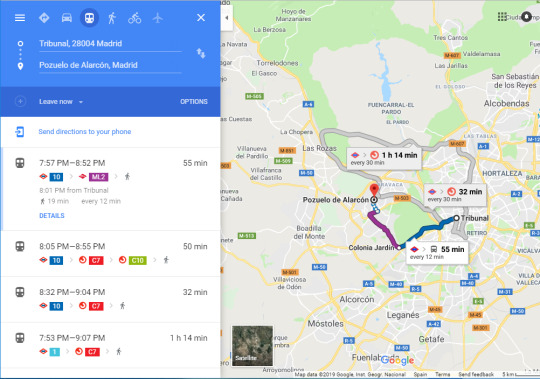
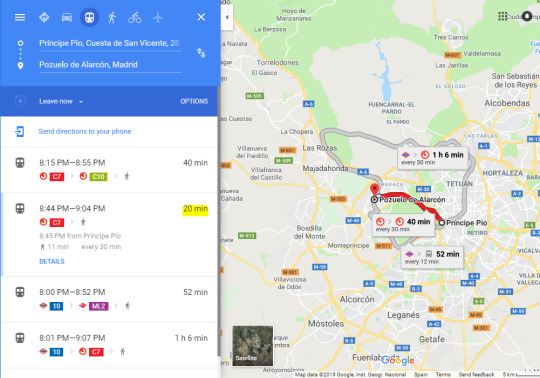
Cristián lives in Pozuelo de Alarcón, an affluent Madrid suburb with its own city hall. At the time, twitter commentary from Spanish viewers was critical of the show choosing to make the girls meet in Tribunal, because public transit from Tribunal to Pozuelo takes too many connections and it’s not like Madrid isn’t rife with convenience stores. I included both the route the girls take, and an alternate for ur edification.
I just realized that when Viri goes over to greet Lara, you can clearly hear Lara saying, “what’s up, dude?” in response.
And also, when Eva begs Nora not to leave her alone, Nora teases Eva by saying the sentence back to her. That’s why Eva laughs and says Nora is being dumb.
A saco (“going all out”): “A saco” is that kind of slang that’s hard to translate, but Eva means that Viri is assertively taking the lead in pursuing (and making it clear she wants to make out with) ALEJANDRO, rather than waiting for him to notice her.
CLIP 6: Viri lost a battle, but she didn’t lose the war!
Nora’s ringtone is so… She truly leaves me speechless sometimes.
No soy celoso (“I’m not possessive”): I translated “celoso” as possessive, because if I translated it as “jealous” it would mean that Cristian, right this moment, doesn’t feel jealous of Jorge. In fact, what Cristian is saying that this is a general personality trait of his, like being blond. He is totally chill with any and all girls he is interested in having boyfriends. That’s not at all an obstacle!
It’s also a very corny thing Spanish guys say all the time when a girl says she’s taken, hence Eva’s uncomfortable smile in response.
As Inés and Alicia greet ALEJANDRO, he seems pretty annoyed by Viri floating around him, clearly laying a claim on him. The three of them intentionally crowd Viri out.
CLIP 7: Hard work pays off
En doce siglos (“in twelve centuries”): This is Amira’s catchphrase for measuring time. She also uses it during the truth or dare game.
One of the season 1 mysteries: what did Alicia say to Inés to make her leave so quickly? In hindsight, it doesn’t seem to have anything to do with Jorge, but that was one of the popular theories at the time.
Another detail: Cristian is behind Inés, seemingly on her side of this girl fight. ALEJANDRO’s crew seems to be pretty friendly with Inés and Alicia. They celebrated Inés’ birthday together, and often post ig stories together.
Social media:
I already mentioned this in a post, but Cris’ instagram makes it very obvious that Cris is a stoner. Her rainbow tops are peak Spanish stoner girl fashion, the soap video she regrammed is the sort of thing a stoner would be fascinated by, she follows ifyouhigh and highpeopledoingstuff, and she’s holding a blunt for her first ever ig pic. So yeah. I also just realized the implications, seeing she’s the s2 main. I don’t think she’ll lose a bunch of weed, but she might smoke it with 🐸?
“Perezón,” i.e. the title of clip 4, would literally translate to sloth or laziness, but its actual meaning is “what a drag,” as in “that party/those people/going to that rally is such a drag.”
Viri’s house is pretty basic-looking. What we can see of it looks like a working class household, but it isn’t the borderline hoarder situation in Vilde’s clip.
Eva watches an 11-episode show, which may or may not be Skam s1. The fun thing is she promises she won’t watch episode 12. The NYE special is listed as episode12 on the Movistar site.
Jorge got ahold of a charger after midnight!
SKAM+ #1:
This clip takes place between episode 2 clips 6 and 7. Specifically, 20 minutes before the last clip.
Aitana is a Spanish singer born in 1999. She became famous thanks to talent show Operación Triunfo, where she came in second. At the time season 1 aired, she had only dropped two songs, Lo Malo with Ana Guerra, and Teléfono. Both of these songs played a prominent role on the show.
Cristian’s dad works at a record label! Explains Cristian’s huge ass house and mixing room!
ALEJANDRO asks Aitana where she’d like to hang out with him at Retiro Park. Retiro Park is one of the largest parks in Madrid. The park belonged to the Spanish Monarchy until the late 19th century, when it became a public park. It’s one of the most picturesque sights in the city and it’s overrun by people. So I don’t think it’s the place you want to take a celeb on a low-key date, but otherwise, good choice! Almost makes it seem like ALEJANDRO isn’t after sex!
Hasta yo preferiría a Aitana (“Even I’d rather Aitana”): That is… so lesbian of Viri.
Speaking of lesbians, Cris is also absolutely overcome by Aitana’s beauty.
In case you weren’t aware, Spaniards greet each other with two cheek kisses when we meet someone. Touching people’s hair without their permission, though, is still a no-no.
15 notes
·
View notes
Text
Documentation and Discussion of my Identity project
For my final outcome I made assets for a character creation game built on a website called Picrew. Including all the icons and colour variations, over 200 .png files were created for this project.
I started by working on the base figure with some pencil drawings in my sketchbook. Then I brought it into the app Procreate and developed the final lineart. I considered having the pose be at an angle to have it look more dynamic. However I realised if I made it from a front facing angle then i could be more efficient. This meant that i could use the symmetry tool for the majority of the drawing stage.
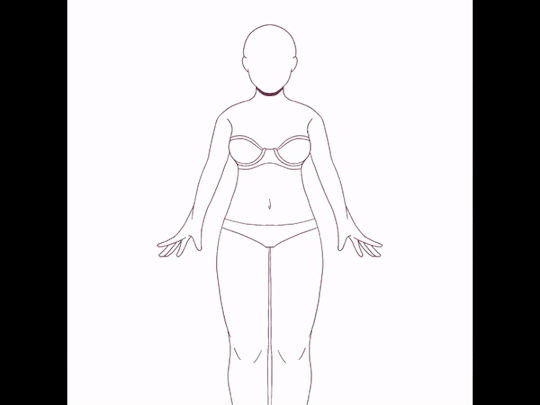
Base model timelapse (2021)
After that I created a 8 different skin tone swatches, and brought it into picrew. I wanted to test this early on so I could check the progress as i went along. I considered using another website called meikor.io , but picrew was much more accessible to me. Once i familiarized myself with the interface, I got to work on some more assets, and imported them in batches.

Eye colour swatches (2021)
Once i started to implement different colour choices, it was important to be organised. I labelled my layer groups numerically to aid with the upload process. Once I had created all the designs, I would duplicate the file and change the colour of the base layer.

Example of layer management (2021)
At this point I thought more critically about the clothes I wanted to include. In earlier stages of the project I was interested in different cultures, so I wanted to include that to some degree.
To ease myself into it I created a few basic t-shirts. Then researched clothes worn in different cultures around the world. In my project I chose to include the following dresses: a dirndl (Germany), bunad (Norway), sari (India), kimono (Japan), and cheongsam (China).
I was having some difficult on the build of a bunad. I understood what it looked like as a whole, but not in sections. However I found a video about tailoring a bunad (Daisy Viktoria, 2021, 12:16). The section where she showed the blouse off was brief, but helpful enough to make my drawing. It wasn't until later that I realised that the same creator had another video giving a full view of the garments [intext citation]. I would have liked to have rectified it, but I considered it a better use of my time to push on forward.
In my research I also came across the book: Dress in detail from around the world Crill, R. et al. (2002). It had flat illustrations of unique necklines, sleeves, and many other details. Page 192 helped me understand the neckline in a cheongsam dress. As with the previous steps, I then created a few colour swatches.
Finally I created a few extra garments, such as a hijab, bhindi, earrings and glasses. I checked over the layer arrangements in picrew and it was complete!
My project connects to our lectures and indirectly challenges structuralist theories of identity. The ability to mix and match multiple different clothes doesn't work on a binary system. The regional dresses are also representative of class, as a dirndl was worn by common folk, and cheongsam was adapted by educated women.
To take this project further i could add some more clothes, particularly from 20th century fashion trends. In this direction I could comment more about subcultures and the significance of clothing to express identity.
This project was a challenge to make since I changed my idea with only a week left of the project. I am happy I did as I'm pleased with the results and it was very much a labour of love.
Originally I wanted to make something connected to street food, since it was an idea that popped up in the urban project. in connection to this I made an illustration of a bento box which i was pleased with aesthetically, but didn't have much capacity to grow.

Bento box (2021)
After some feedback I decided to work on dumpling illustrations, since they are a form of 'box'. However, their simplicity would've lead to flat looking line drawings, and I struggled to render them.

Dumpling studies (2021)
I had a dress up game in the back of my mind, and I was given the signal to just go for it. In the end, I'm happy that I did.
----------
Base model timelapse (2021) [Screenshot]. Available at: https://64.media.tumblr.com/3135acc5e349c01ac978a9b234ef9ade/4e6df516793d6008-1b/s500x750/73f391e7f4050bef68e805039cfa5f072526a58d.gifv (Accessed: 28 November 2021).
Bento box (2021) [Screenshot]. Available at: https://64.media.tumblr.com/6affbe46c2d4da922302d6a580e723a8/4e6df516793d6008-bb/s540x810/0645da0b1f4baac2718fd366af34a4700d37cb35.jpg (Accessed: 28 November 2021).
Crill, R. et al. (2002) Dress in detail from around the world . London: V&A.
Daisy Viktoria (2021) HISTORICALLY ACCURATE ELSA || I Made an 1840s Norwegian Bunad. 15th January Available at: https://www.youtube.com/watch?v=m78xSpsZ9JU (Accessed: 25th November 2021).
Daisy Viktoria (2021) What Would Elsa ACTUALLY Wear? Getting Dressed in 1840s Norwegian Bunad | Historically Accurate GRWM. 22 January. Available at: URL (Accessed: 28 November 2021).
Dumpling studies (2021) [Screenshot]. Available at: https://64.media.tumblr.com/b2a62068edd10ab64abff504415fa81a/4e6df516793d6008-7b/s500x750/35621ee54ebfa97453b5af9644db89cb4073d136.jpg (Accessed: 28 November 2021).
Example of layer management (2021) [Screenshot]. Available at: https://64.media.tumblr.com/5ab815bf9222e1c9f4ca45ed9ba5d527/4e6df516793d6008-ca/s500x750/3c3a0b606809faf45ad4e0565955edc86b242607.png (Accessed: 28 November 2021).
Eye colour swatches (2021) [Screenshot]. Available at: https://64.media.tumblr.com/2ae666223cb5b328a5b2b283bb23360a/4e6df516793d6008-1c/s500x750/437e38392d9a6fb71411b795b3cb7f9d27f2287a.png (Accessed: 28 November 2021).
0 notes
Note
*Do you hate Norwegian people/have something against them because of the colonization of the Sámi people and Sápmi? I don’t mean anything bad by it, I’m just a bit curious on have you feel about Norwegian people.
Also is it weird for you guys when Norwegian people keep close with their cultural ties? My friend is very close to her Norwegian culture by wearing her søljer (?) often, practicing traditional dances, make clothes based on her bunad, learn old Norwegian folksongs and tries to get other Norwegians to be more in touch with their culture because she thinks many Norwegians don’t give a shit anymore. Is that uncomfortable for Sámi people? She’s a bit afraid of that, she said that she didn’t want anyone to be uncomfortable by it, escpically Sámi and other minorities who were colonized by Norwegians. She’s afraid that her showing of Norwegian people might cause very bad memory for the elders. And she feels it’s very wrong for her since nasjonalromantikken (?) was about creating a Norwegian identity and show of Norwegian culture, and while that was happening, Norwegian was off discriminating and colonizing people. Basically, she feels bad for practising her culture because of Norway’s history of erasing other cultures.
Also, stupid question (not my by me, but from my friend), is she allowed to wear gákti because her Sámi friend wanted too? My friend joined the demostration in Oslo yesterday, and her Sámi friend (who couldn’t join) wanted her to wear her gákti as a sign of greatfullness and a sign of their friendship. My friend said no, because she didn’t want to offend other Sámi people and because it wasn’t right since it wasn’t her culture and her history. Did she make the right call?
(Also hating the Norwegian government and history is valid af! Love that!)
are you asking me if I think it’s okay to be norwegian?
for the last question, I’d say it’s not necessarily wrong to wear it if their friend offered, but this isn’t really common and I wouldn’t be comfortable with it. Rare enough that I’m not sure how to answer it and i’ve never heard of anyone I know doing that. It’s possible they asked because they wanted your friend specifically to wear it inside out because that’s a protest symbol and they wanted as many visible inside out gáktis as possible.
22 notes
·
View notes
Note
Just gonna chime in in terms of dating Frozen that it’s very anachronistic. Anna wears a bunad (Norwegian folk costume, with different regions having different bunads) that dates all the way back to the 1930’s. Specifically, she wears a nordlandsbunad. She also at times wears Sami-inspired costumes, the Sami being an altogether different ethnic group. On the other hand, Elsa is specifically queen of Arendelle only, indicating the regions of Norway haven’t been united yet (this happened in the ~10th century) but she’s queen, and these regions had chiefs. Basically, her political position has never existed in Norway.
Frozen is set in an alternate universe with Norwegian aesthetics, but that’s as far as the similarity goes. You will find no historical period corresponding with the world of Frozen.
Could you expand on the Frozen section of this post (https://thecarnivorousmuffinmeta.tumblr.com/post/664401388257918976/i-loved-the-ask-about-the-volturi-but-actually) a little bit? Do Elsa's snow people go with her to Volterra? How does Anna and Elsa's presence as members of the Volturi affect the actual story of Twilight thousands of years later? Would Olaf and Emmett be bros?
Anon's referring to my discussion of what works when crossed over with Twilight and what falls on its face. My argument for Frozen was that Elsa, with the very clear usage of her gift, would sooner or later find herself turned and becoming a member of the Volturi (perhaps Anna as well).
I mean, it was really more of a thought exercise than anything else, what you're asking goes way off into headcanon land/write the fic territory. But I guess I can give off the cuff responses.
Do Elsa's Snow People Go with Her to Volterra?
Probably. Those things roaming around is a large breach of the secret and that's a very useful portion of Elsa's power. Given that they can survive in warm temperatures with Elsa's help, there's not really a necessity for them to stay on Arendelle's glaciers.
How Does Anna and Elsa's Presence as Volturi Affect Twilight Thousands of Years Later?
Thousands of years? Oh man, anon, I mean... We're really going into AU crossover land. If I had to place the timeline of Frozen I'd probably say 18th century. They don't have cars yet but the clothing, the military dress, the technology (things like the dam having been built decades before, the way the ships look, etc.), Christian symbolism (Elsa is coronated holding the orb and scepter), all point to waaaaay sooner than several thousand years ago.
I'll put it like this, Elsa is not queen of the Vikings.
But I will place them probably 100-200 years before Bella Swan will be born.
Regardless, they have no effect on the story. Elsa is extremely powerful but ice and snow aren't the same... detriment to vampires. Unless her gift has become even radically more powerful in ways that are conveniently useful (which is possible as she was stupid powerful to begin with) then in the confrontation during Breaking Dawn, Elsa's gift while employed is unable to threaten the sudden Cullen supremacy due to Bella's gift. Unless she can take out Bella any more than any of the others can, the Volturi is in the same place they were.
If Anna is gifted, same rules, unless it takes out Bella it won't make a difference.
There's no other point where Anna and Elsa are likely to meet with Bella, to do so would be going very out of their way and plunge is into very AU land.
Would Olaf and Emmett be Bros?
Given the confrontation between the Cullens and Volturi and that Emmett never meets the Volturi until Breaking Dawn and has 0 chance of having run into Olaf: No.
As it is, I think Emmett would find Olaf weird and alarming. He tries to make jokes about it but then you have Olaf noting that "I have no bones" or "I like warm hugs". Emmett just can't win.
#twilight#frozen#twilight meta#frozen meta#twilight headcanon#frozen headcanon#anna#elsa#olaf#bella swan#the carnivorous muffin#thecarnivorousmuffinmeta
70 notes
·
View notes
Text
Fan account of Det Går Bra
Our translator, Anna, got a chance to see Tarjei’s play in Oslo! Her account is below the cut. We want to remind people that this play is an exaggeration of truths in the actor’s lives. Tarjei is playing a ‘douchey’ version of himself etc. We do not know the extent of the truth behind his confessions in the play.
Trigger warnings for mentions of rape, please proceed with caution.
The theater is right next to Elvebakken. In this area that’s kind of been hijacked by creative people. A lot of interesting stuff going on there. Art, dance, theater etc.
We all met up at the entrance and then a woman came and took us around the building, and down a narrow staircase that went deep into a basement. My friend almost couldn't go down there because she’s claustrophobic.
It was a fairly small black room with chairs all along the walls sort of like a circle/square with a long black table in the middle, and that was the scene. And a few props and boxes around the room.
The room was jammed packed so some people had to sit sort of in the back. I did not envy them and I’m glad we came there early. A few chairs amongst the audience had cards that said “reserved” on them. I had a vague feeling these chairs had to do with the show so I made sure not to sit next to them. Two fans who looked Chinese or Korean sat next to the reserved chair who was closest to me and my friend. And this was the chair Tarjei used during the show to sit on. Like what in the hell. What are the odds. The Chinese girl acted like she was about to faint every time he came and sat next to her.
And then all the lights went out and a guy came in with a flashlight. He walked around the table flashing people with it as he went by, saying “Går det bra?” (Are you okay-like ‘how are you guys doing’) He kept repeating it so we thought we were supposed to reply, but then he sort of became manic and started running around faster and faster and talking louder and louder until he was screaming on top of his lungs. With the flashlight going it was actually quite scary and I had to hide behind my scarf, lol.
And that sort of set the tone for the entire show. You didn’t quite know whether to laugh or cry. It really reminded me of Festen by Lars Von Trier. Funny but dark and uncomfortable at the same time. Very Scandinavian social realism i you know what I mean. Anyways.
And then the actors came into the room one by one, which was still pitch black. And they introduced themselves and talked about themselves. Kind of revealing inner thoughts that you should keep to yourself, like “I’m Tina and I spend most of my days sleeping, I don’t read the paper, I don’t vote, I hate it when my friends talk about their problems etc etc.”
When Tarjei suddenly ran onstage in a really beautiful Bunad (our national costume) I was so surprised that I wasn’t listening to a word he was saying to be honest. And my friend kept hitting me and I was scared to even look at him. I just remember him holding up a phone and reading messages off of it. Negative stuff. Can’t remember what. But it was directed at him.
And then the next scene is a party where they’re all supposed to be drunk and one guy stands to his feet and holds a speech and everything it gets really awkward. In the beginning I was sort
of thinking what the hell have I gotten myself into, I don’t want to be part of this awkwardness. But then the play just sucked you in and got better and better.
Tarjei plays the little brother of one of the girls. Her name was Moe as well? So maybe it’s his half sister, idk? She was really tall and skinny. And funny.
I can’t remember all the scenes chronologically. Only bits and pieces, so I hope it’s ok that I just write it like that, randomly.
But the play is about a group of friends who fall out. It starts out with the one guy, the main I guess, who says that they should all try in the next year and be more open and honest with each other. And then the show shows different scenes over the next year and how that completely breaks the friendships apart and it all goes to hell. The play ends with the same party (17th of may party like in the beginning. 17th of may is our independence day where everyone wears their nice clothes and drinks all day/ too much and it often ends in a catastrophe)
And all the scenes are very dark and awkward. And very physical for the actors. Like they run around and use their bodies. So even if you wouldn’t understand you’d get an idea of what it was about and enjoy watching it I think?
They go to sit in between the audience all throughout the play.
They all sit on the reserved chairs when the confession time begins. It’s pitch black and they each hold a flashlight which they light at one another when they speak.
Tarjei talks about how at the bus the other morning on the way to school he saw a really cute girl. And he has this thing where he stares at people, anyone, he can’t look away and it’s really embarrassing. So he was sitting there staring at her. And then he noticed that she was carrying some heavy bags and he wanted to go up and help her, but then he thought that he’d be that douche actor who goes up to cute girls in the early morning trying to hit on them. But then she’d noticed him staring at her and he got scared that she’d noticed him noticing the heavy bags. And now he wasn’t only the douche actor who stared at girls on the bus in the morning, but he was also the douche actor from SKAM who stared at girls and didn’t help them when they clearly needed help. And then he had anxieties about it for the rest of the day or something. I can’t remember exactly.
And then all of them shared awkward stuff about themselves. Some of it funny. Like intimate stiff. One girl talked about going to the gynecologist. And then one guy alluded to being abused by his grandfather and when he finished talking Tarjei blurted out “I’ve been raped.”
And not in a ha ha way at all. The room basically held their breath because the atmosphere was so coloured by what was being said. And then the whole thing ended in a sort of nightmare and I almost pissed myself and wanted to run away.
There’s also a scene between his sister and him where she’s really upset about how much weed he smokes and she almost starts crying.
And there's a scene where he takes drugs and drinks vodka and dances like a maniac. Like flash dance x 10000. In the end he’s basically laying in a bridge on the floor convulsing.
And then the other guys roll around the floor embracing and touching and saying how much they love each other.
He also wears russ overalls, gets in a physical fight with one of the older men and is pushed half ways across the room. And it’s a proper push too because he made a grunting sound like all the air went out of him.
It’s just really raw and gritty.
Oh, and he sings too!! And it’s good!
A girl who’s supposed to be really correct and annoying is talking over everyone and suddenly he grabs a microphone and starts singing lol. Everyone was laughing. Tarjei definitely got a lot of laughs and gasps. His delivery is just really good and powerful.
At the end he gives a sort of rambling monologue where he says something about skam again, but I can't remember exactly what it was. But just how he felt bad about not knowing enough about politics, not knowing what to vote, about feeling selfish because he grew up in Norway as a young white boy and privileges etc etc. He sounded really insightful and anxious and worried.
And there was sooooo much more, but this is all I can remember right now.
His shoulders are hunched over a bit when he stands, but he moves with confidence and isn’t awkward at all. And nothing he does looks dumb, if you know what I mean. He’s a pleasure to watch onstage. He outshone everyone, even though he’s got the least speaking parts. (But still quite a lot, but not as much as the others) It was weird but I felt like I was watching a version of Isak up there. Only in a completely different setting.
I’m in love/the end.
214 notes
·
View notes
Note
but the issue some of us have isn't with the Russbuss plot! we understand that it's very important in Norway, and that's fine! it looks fun and someting Norway should export :) what some of us don't like is the way the Bus is WRITTEN. As for Sana and the Bus, yes, it's a very relevant topic. The complaint is that Sana feels too much of an observer, even if the point is to show her isolatio. As for Norwegian things, why not showing Norway's national day in Sana's season? unwise choice, I think.
Halla anon! Song of the day to calm your thoughts if they need calming is here (everyone’s thoughts need calming sometimes, even mine. It’s called Glass, by MØ).
To your questions: “The complaint is that Sana feels too much of an observer”, “Why not show Constitution Day aswell?”. Honestly, I feel that these questions aren’t going to have a yes/no answer, since it’s opinionated. So basically, it’s really lovely you have your opinion! Seriously! :D It shows you care about Skam and that you take time out to think about it:)
I’m not going to be able to answer this without showing my opinion aswell, which is that I have no complaints. I’m really enjoying this season so far. I have no control over the manuscript, so what’s the point of me complaining and thinking slightly negative thoughts about the season? It is physically impossible for any tv-show to make 100% of the audience happy. And I guess that’s just the way it is. I have my full trust and emotions in Julie and Co. They are sure to make this season go off in a blast, like earlier seasons! I guess, if you don’t like how it’s written, then maybe you could turn the slight annoyance that you may have into something creative, for example, you could write your own Skam manuscript about how you wanted the Russbussplot to have gone. That could be really interesting to read!
In regards to your second question: we were shown Constitution Day last year, in S2, which was lovely. But I feel that this season, we are closer to the Russbussplot than ever before. Yes, it could’ve been so, so lovely to have seen everyone in their Bunad’s having a dandy time, but alas, that didn’t happen. Time to move on and prepare to fangirl/fanboy/fannon-binary (whichever applies) on Monday. Have a lovely weekend, thanks for the ask, hope you liked my boring, mature answer lol :P (And that you liked the song!!)
From, Natacha :o)
8 notes
·
View notes